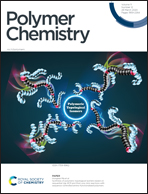Light-induced spherical to dumbbell-like morphology transition of coumarin-functionalized latex nanoparticles by a [2π + 2π] cycloaddition reaction: a fast and facile strategy to anisotropic geometry†
Abstract
Photo-controlling of the shape and morphology of polymer nanoparticles or assemblies is an interesting challenge, which could be studied by the incorporation of light-responsive compounds into the polymer particles. Here, a novel strategy was developed for the fast and facile light-induced morphology transition of functional latex nanoparticles from spherical to anisotropic (dumbbell-like and patchy) by surface-incorporation of coumarin derivatives (hydroxylated and carboxylated coumarin) via post-polymerization modification methods. For this purpose, polystyrene latex nanoparticles with different functional groups (carboxyl, epoxy, and hydroxyl) were prepared by emulsifier-free emulsion polymerization and characterized by Fourier-transform infrared spectroscopy and differential scanning calorimetry. The nanoparticles display different spherical, doughnut-like, and red blood cell-like morphologies in scanning electron microscopy (SEM) and transmission electron microscopy (TEM) images. The dimerization of the surface coumarin molecules upon UV illumination (365 nm) by a [2π + 2π] cycloaddition reaction resulted in a remarkable increase of particle size in spherical latex nanoparticles from 195 (unimodal) to 930 nm (bimodal) in dynamic light scattering curves. In addition, a slight decrease of particle size was observed for the doughnut-like and red blood cell-like latex nanoparticles because of intraparticle dimerization of coumarin molecules leading to photo-crosslinking and shrinkage of the particles. Light-induced particle size variation was a result of transition of geometry from spherical to dumbbell-like and other patchy particles via interparticle chemical interactions, as clearly confirmed by the SEM and TEM images. The investigation of coumarin dimerization by UV-vis and fluorescence spectroscopy shows that half of the coumarin molecules undergo cyclization after 8.5 h (T1/2) of UV irradiation, and further irradiation can result in particle aggregation. TEM analysis of the light-induced morphology transition after 10 h UV light irradiation indicates a significant decrease of particle aggregation and increase of dumbbell-like particles, which is a powerful confirmation for light-induced morphology transition controlled by the UV irradiation time. This is the first report on light-induced morphology transition of spherical polymer nanoparticles to anisotropic shapes, which could be a potential strategy for the preparation of dumbbell-like, patchy, or even Janus particles by coumarin dimerization via the [2π + 2π] cycloaddition reaction under UV light.
![Graphical abstract: Light-induced spherical to dumbbell-like morphology transition of coumarin-functionalized latex nanoparticles by a [2π + 2π] cycloaddition reaction: a fast and facile strategy to anisotropic geometry](/en/Image/Get?imageInfo.ImageType=GA&imageInfo.ImageIdentifier.ManuscriptID=D0PY00078G&imageInfo.ImageIdentifier.Year=2020)


 Please wait while we load your content...
Please wait while we load your content...